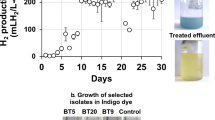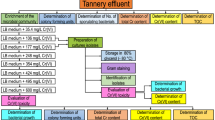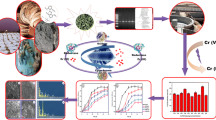Abstract
A native Bacillus cereus isolate has been employed, for the first time, for simultaneous decolorization, dechlorination of chloroorganics, and Cr6+ remediation from the real tannery effluent. Most of the physicochemical variables in 3:1 diluted effluent were well above the standard prescribed limits, which decreased substantially upon microbial treatment. The extent of bioremediation was better in diluted (3:1) as compared to undiluted effluent supplemented with nutrients and augmented with B. cereus isolate. Maximum growth, effluent decolorization (42.5 %), dechlorination (74.1 %), and Cr6+ remediation (34.2 %) were attained with 4.0 % (v/v) inoculum, 0.8 % glucose, and 0.2 % ammonium chloride in 3:1 diluted effluent at natural pH (8.1) within 72 h of incubation. The efficiency of bioremediation in a bioreactor was higher as compared to a flask trial during 72 h of incubation: decolorization (47.9 %) was enhanced by 5.4 %, dechlorination (77.4 %) by 3.3 %, and Cr6+ removal (41.7 %) by 7.5 % at an initial color of 286 Pt-Co units and initial concentration of 62 mg chloride ions and 108 mg l−1 Cr6+. Immobilized biomass of Pseudomonas putida and B. cereus coculture enhanced the extent of Cr6+ remediation (51.9 %) by 10.2 % compared to the bioreactor trial. Chromate reductase activity and reduced Cr directly correlated and were mainly associated with soluble fraction of B. cereus plus effluent natural microflora. The GC-MS analyses revealed the formation of metabolites such as acetic acid and 2-butenoic acid in bacterially treated effluent. The supplementation of nutrients along with B. cereus augmentation is required for efficient effluent bioremediation.









Similar content being viewed by others
References
Amudeswari A, Sarvanan J, Rao R, Ramasami T (2009) Leather bioprocessing: a greener finish. Biotech News 4(1):4–8, 22
APHA (1998) Standard methods for the examination of water and wastewaters, 20th edn. APHA, AWWA, WPCF, Washington, DC
Basu M, Bhattacharya S, Paul AK (1997) Isolation and characterization of chromium-resistant bacteria from tannery effluent. Bull Environ Contam Toxicol 58:535–542. doi:10.1007/s001289900368
Benazir JF, Suganthi R, Rajvel D, Pooja MP, Mathithumilan B (2010) Bioremediation of chromium in tannery effluent by microbial consortia. Afr J Biotechnol 9(21):3140–3143
Bergmann JG, Sanik J (1957) Determination of trace amounts of chlorine in naphtha. Anal Chem 29:241–243. doi:10.1021/ac60122a018
Bhide JV, Dhakephalkar PK, Paknikar KM (1996) Microbiological process for the removal of Cr (VI) from chromate-bearing cooling tower effluent. Biotechnol Lett 18:667–672. doi:10.1007/BF00130763
Bradford MM (1976) A rapid and sensitive method for the quantification of micrograms quantities of protein utilizing the principle of protein dye binding. Anal Biochem 72:248–254. doi:10.1016/0003-2697(76)90527-3
Camargo FAO, Okeke BC, Bento FM, Frankenberger WT (2003) In vitro reduction of hexavalent chromium by a cell-free extract of Bacillus sp. ES 29 stimulated by Cu2+. Appl Microbiol Biotechnol 62:569–573. doi:10.1007/s00253-003-1291-x
Chandra R, Bhargava RN, Kapley A, Purohit HJ (2011) Bacterial diversity, organic pollutants and their metabolites in two aeration lagoons of common effluent treatment plant (CETP) during the degradation and detoxification of tannery wastewater. Biores Technol 102:2333–2341. doi:10.1016/j.biortech.2010.10.087
Chen JM, Hao OJ (1996) Environmental factors and modeling in microbial chromium (VI) reduction. Water Environ Res 68:1156–1164
Copley SD (2000) Evolution of metabolic pathway for degradation of a toxic xenobiotic: the patchwork approach. Trends Biochem Sci 25:261–265
CPPA (1974) Technical section standard method H5P. Montreal, Canada: Canadian Pulp and Paper Association
Daraei H, Mittal A, Mittal J, Kamali H (2013a) Optimization of Cr (VI) removal onto biosorbent eggshell membrane: experimental & theoretical approaches. Desalination Water Treat. doi:10.1080/19443994.2013.787374
Daraei H, Mittal A, Noorisepehr M, Mittal J (2013b) Separation of chromium from water samples using egg shell powder as a low-cost sorbent: kinetic and thermodynamic studies. Desalination Water Treat. doi:10.1080/19443994.2013.837011
Deiana S, Premoli A, Senette C (2007) Reduction of Cr (VI) by caffeic acid. Chemosphere 67:1919–1926. doi:10.1016/j.chemosphere.2006.12.003
Ganguli A, Tripathi AK (1999) Survival and chromate reducing ability of Pseudomonas aeruginosa in industrial effluents. Lett Appl Microbiol 28:76–80
Garg SK, Tripathi M (2011) Strategies for decolorization and detoxification of pulp and paper mill effluent. Rev Environ Contam Toxicol 212:213–236. doi:10.1007/978-1-4419-8453-1_4
Garg SK, Tripathi M, Srinath T (2012) Strategies for chromium bioremediation from tannery effluent. Rev Environ Contam Toxicol 217:75–140. doi:10.1007/978-1-4614-2329-4_2
Garg SK, Tripathi M, Singh SK, Singh A (2013) Pentachlorophenol dechlorination and simultaneous Cr6+ reduction by Pseudomonas putida SKG-1 MTCC (10510): characterization of PCP dechlorination products, bacterial structure, and functional groups. Environ Sci Pollut Res 20:2288–2304. doi:10.1007/s11356-012-1101-z
Gupta VK, Rastogi A (2008) Sorption and desorption studies of chromium (VI) from nonviable cyanobacterium Nostoc muscorum biomass. J Hazard Mat 154:347–354
Haggblom M (1990) Mechanisms of bacterial degradation and transformation of chlorinated monoaromatic compounds. J Basic Microbiol 30(2):115–141
Horitsu H, Futo S, Miyazawa Y, Ogai S, Kawai K (1987) Enzymatic reduction of hexavalent chromium by hexavalent chromium tolerant Pseudomonas ambigua G-1. Agri Biol Chem 51:2417–2420
Ilias M, Rafiqullah IM, Debnath BC, Mannan KSB, Hoq MM (2011) Isolation and characterization of chromium (VI)-reducing bacteria from tannery effluents. Indian J Microbiol 51(1):76–81. doi:10.1007/s12088-011-0095-4
Ito M, Ohnishi Y (1982) Escherichia coli mutants which are resistant to uncouplers of oxidative phosphorylation. J Microbiol Immunol 26(11):1079–1084
Jawahar AJK, Ponselvan JKS, Chinnadurai M, Annadurai G (1998) Pollution from tanneries and options for treatment of effluent. Indian J Environ Prot 18:672–678
Kolhe AS, Pawar VP (2011) Physico-chemical analysis of effluents from dairy industry. Recent Res Sci Technol 3(5):29–32
Liu YG, Xu WH, Zeng GM, Li X, Gao H (2006) Cr (VI) reduction by Bacillus sp. isolated from chromium landfill. Process Biochem 41:1981–1986. doi:10.1016/j.procbio.2006.04.020
Lopez A, Lazaro N, Marques AM (1997) The interface technique: a simple method of cell immobilization in gel beads. J Microbiol Methods 30:231–234
Masood F, Malik A (2011) Hexavalent chromium reduction by Bacillus sp. strain FM1 isolated from heavy-metal contaminated soil. Bull Environ Contam Toxicol 86:114–119. doi:10.1007/s00128-010-0181-z
Masood F, Malik A (2012) Biosorption of metal ions from aqueous solution and tannery effluent by Bacillus sp. FM1. J Environ Sci Health. Part A: Toxic/Hazard Subs Environ Eng 46:1667–1674
Nikolaidis NP, Hellerich LA, Lackovic JA (1999) Methodology for site-specific mobility based clean up standards for heavy metal in glaciated soils. Environ Sci Technol 33:2910–2916
Paisio CE, Talano MA, Gonzalez PS, Busto VD, Talou JR, Agostini E (2012) Isolation and characterization of a Rhodococcus strain with phenol-degrading ability and its potential use for tannery effluent biotreatment. Environ Sci Pollut Res 19:3430–3439
Pal A, Dutta S, Paul AK (2005) Reduction of hexavalent chromium by cell-free extract of Bacillus sphaericus AND 303 isolated from serpentine soil. Curr Microbiol 66:327–330. doi:10.1007/s00284-005-0048-4
Poopal AC, Laxman RS (2008) Hexavalent chromate reduction by immobilized Streptomyces griseus. Biotechnol Lett 30:1005–1010
Rajamani S, Ramasami T, Langerwerf JSA, Schappman JE (1995) Environment management in tanneries, feasible chromium recovery and reuse system. In: Proc. of the 3rd international conference on appropriate waste management technologies for developing countries, Nagpur, pp 965–973
Ramteke PW, Awasthi S, Srinath T, Joseph B (2010) Efficiency assessment of common effluent treatment plant (CETP) treating tannery effluents. Environ Monit Assess 169:125–131
Rida B, Yrjala K, Hasnain S (2012) Hexavalent chromium reduction by bacteria from tannery effluent. J Microbiol Biotechnol 22(4):547–554
Sau GB, Chatterjee S, Sinha S, Mukherjee SK (2008) Isolation and characterization of a Cr (VI) reducing Bacillus firmus from industrial effluents. Polish J Microbiol 57:327–332
Singh SK, Singh SK, Tripathi VR, Khare SK, Garg SK (2011) A novel psychrotrophic, solvent tolerant Pseudomonas putida SKG-1 and solvent stability of its psychro-thermoalkalistable protease. Process Biochem 46:1430–1435. doi:10.1016/j.procbio.2011.03.012
Snehal VM, Sheeja J, Rao BS, Balachandranan UN, Laxman RS (2002) Chromium removal and reduction in COD of tannery effluents. Indian J Environ Health 44:320–328
Srinath T, Garg SK, Ramteke PW (2003) Biosorption and elution of chromium from immobilized Bacillus coagulans biomass. Indian J Exp Biol 41:986–990
Srivastava S, Ahmad AH, Thakur IS (2007) Removal of chromium and pentachlorophenol from tannery effluent. Biores Technol 98:1128–1132. doi:10.1016/j.biortech.2006.04.011
Steel R, Torrie JH (1992) Principles and procedures of statistics. McGraw, New York
Sultan S, Hasnain S (2012) Chromium (VI) reduction by cell free extract of Ochrobactrum anthropi isolated from tannery effluent. Bull Environ Contam Toxicol 89:152–157. doi:10.1007/s00128-012- 0648-1
Thakur IS, Verma P, Upadhyaya KC (2001) Involvement of plasmid in degradation of pentachlorophenol by Pseudomonas sp. from a chemostat. Biochem Biophy Res Comm 286:109–113
Tripathi M, Garg SK (2013) Co-remediation of pentachlorophenol and Cr6+ by free and immobilized cells of native Bacillus cereus isolate: spectrometric characterization of PCP dechlorination products, bioreactor trial and chromate reductase activity. Process Biochem 48:496–509. doi:10.1016/j.procbio.2013.02.009
Tripathi M, Mishra SS, Tripathi VR, Garg SK (2011a) Predictive approach for simultaneous biosorption of hexavalent chromium and pentachlorophenol degradation by Bacillus cereus RMLAU1. Afr J Biotechnol 10(32):6052–6061
Tripathi M, Vikram S, Jain RK, Garg SK (2011b) Isolation and growth characteristics of chromium (VI) and pentachlorophenol tolerant bacterial isolate from treated tannery effluent for its possible use in simultaneous bioremediation. Indian J Microbiol 51:61–69. doi:10.1007/s12088-011-0089-2
US EPA (1979) Economics of wastewater treatment alternatives for the electroplating industry. In: US EPA technology transfer report, Environment Protection Agency 625/5-79-016, June. U. S. Environmental Protection Agency, Washington, DC
Usha K, Kalaiselvi K (2009) Physico-chemical analysis and microbial characterization of tannery effluent. J Ecobiol 25:163–166
Viera RHSF, Volesky B (2000) Biosorption: a solution to pollution? Int Microbiol 3:17–24
Wang YT, Shen H (1995) Bacterial reduction of hexavalent chromium. J Ind Microbiol 14:159–163
Wang YT, Xiao CS (1995) Factors affecting hexavalent chromium reduction in pure cultures of bacteria. Water Res 29(11):2467–2474
Xu WH, Liu YG, Zeng GM, Li XY, Song HX, Peng QQ (2009) Characterization of Cr (VI) resistance and reduction by Pseudomonas aeruginosa. Trans Nonf Met Soc China 19:1336–1341. doi:10.1016/S1003-6326(08)60446-X
Xu L, Luo M, Li W, Wei X, Xie K, Liu L, Jiang C, Liu H (2011) Reduction of hexavalent chromium by Pannonibacter phragmitetus LSSE-09 stimulated with external electron donors under alkaline conditions. J Hazard Mater 185:1169–1176. doi:10.1016/j.jhazmat.2010.10.028
Yang RD, Humphrey AE (1975) Dynamic and steady state studies of phenol biodegradation in pure and mixed cultures. Biotechnol Bioeng 17:1211–1235
Zhao C, Yang Q, Chen W, Teng B (2012) Removal of hexavalent chromium in tannery wastewater by Bacillus cereus. Can J Microbiol 58(1):23–28. doi:10.1139/W11-096
Acknowledgments
The authors express sincere thanks to the Sophisticated Advanced Instrumentation Facilities, Indian Institute of Technology, Bombay, India for the GC-MS analysis. Facilities provided by the Government of Uttar Pradesh under Centre of Excellence and Government of India’s DST-FIST schemes are duly acknowledged.
Author information
Authors and Affiliations
Corresponding author
Additional information
Responsible editor: Gerald Thouand
Rights and permissions
About this article
Cite this article
Tripathi, M., Garg, S.K. Dechlorination of chloroorganics, decolorization, and simultaneous bioremediation of Cr6+ from real tannery effluent employing indigenous Bacillus cereus isolate. Environ Sci Pollut Res 21, 5227–5241 (2014). https://doi.org/10.1007/s11356-013-2479-y
Received:
Accepted:
Published:
Issue Date:
DOI: https://doi.org/10.1007/s11356-013-2479-y




